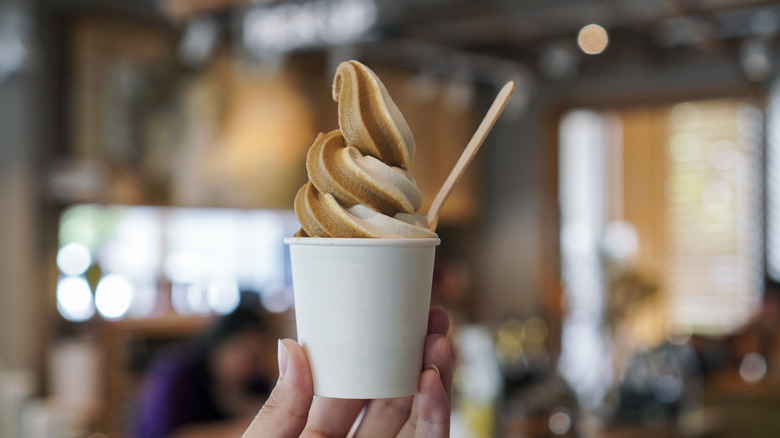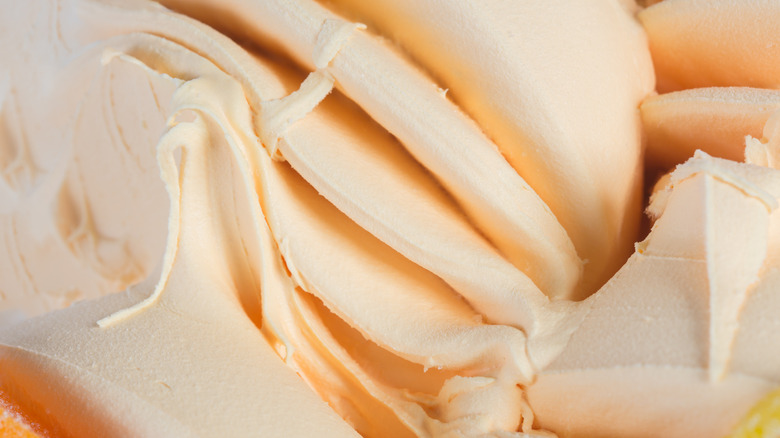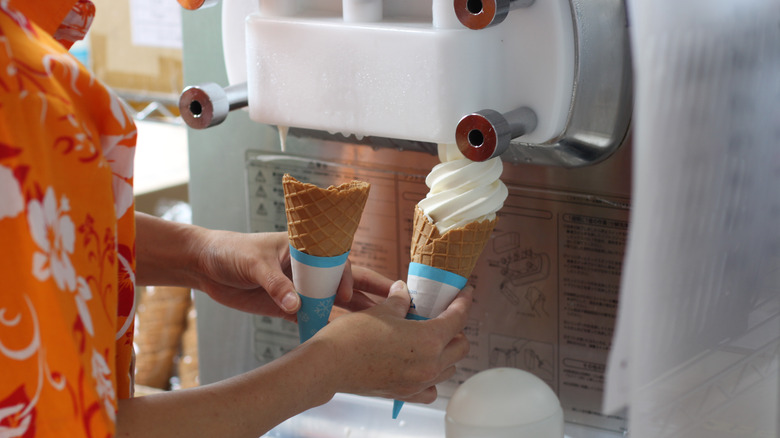Custard Vs Soft Serve Ice Cream: What's The Difference?
We all scream for ice cream. That's a given, but really, we'll scream pretty indiscriminately for anything cold and creamy — be it fro-yo, custard, sorbet, soft serve, or gelato. There's a whole vast world of indulgent chilly treats out there — enough to give you a serious brain freeze while confusing you on the technical differences between the categories.
We tend to use many terms interchangeably, but actually, serious ice cream lovers should know the difference between the wide world of treats, such as custard vs soft serve, which are similar, but also totally unique. We don't say no to any cool scoopable treat, cone or cup, in any flavor. But when the craving hits, there are plenty of distinct differences between custard and soft serve in terms of ingredients, preparation, and ultimately, taste. One key ingredient is the primary difference, and that is egg. Custard must contain eggs to qualify as such, but soft serve is made without it.
Custard contains eggs
If you've heard the term custard and been confused about whether it's the same thing as frozen custard, the answer is yes and no depending on the context. We're discussing frozen custard here, but there's also regular custard, a whole separate dessert technically that isn't frozen. Think the gelatinous basic vanilla pudding or the base of a berry trifle.
Frozen custard is the frozen version of a similar recipe — and therein lies its main difference from soft serve or other ice creams. Just as a non-frozen custard is made with eggs to achieve its jelly-like thickness, so is frozen custard, which gives it a richer, fuller mouthfeel compared to most other frozen treats made primarily with a base of only milk.
Less commonly found in mainstream markets as other frozen treats, custard has a certain old-fashioned, comforting, homespun feel to it. It just feels like taking a page out of a recipe book from generations gone by, or something homemade your grandma would make you. But lest you think just anything frozen and made with egg qualifies as a custard, there are actually quite strict guidelines set by the USDA as to what technically qualifies as a custard. A recipe must contain 1.4% egg yolk solids, and milk fat must make up at least 10% of the recipe. You can make your own and infuse it with chocolate, berries, fresh peaches, or crumbled cookies for a super decadent, dense treat.
Soft serve's texture sets it apart
You can't separate nostalgia from a swirling tower of soft serve. The treat basically screams childhood, summertime, and carefree vibes. As a treat often served from a self-serve machine offering vanilla, chocolate, or a swirl of both, soft serve isn't found in the ice cream aisle. Instead, it's found at ice cream shops, restaurants, and many a theme park.
As the name suggests, there's no need to hack away at a frozen brick of ice cream here, because soft serve is inherently super smooth, soft, and light. It's easy to pour in swirled ribbons into a cup and better eaten fast, before it melts. Soft serve and ice cream are made from the same basic ingredients — milk, sugar, cream, and so on — but soft serve is typically whipped up with less milk fat compared to harder cartons of ice cream, which gives it its light-as-air texture and super slurpable consistency.
The treat is made inside the soft serve machine you see it served out of, and this is crucial to the process. As the machine churns while it freezes the ingredients, it creates a final product that's stored at a just-cold-enough temperature to keep it soft without melting. Craving the old-school treat? Your best bet, short of investing in a time machine back to childhood summers, is to hit up one of the top spots across the U.S. dishing up soft serve, or to find a local ice cream shop in your area that serves old-fashioned cool treats.


